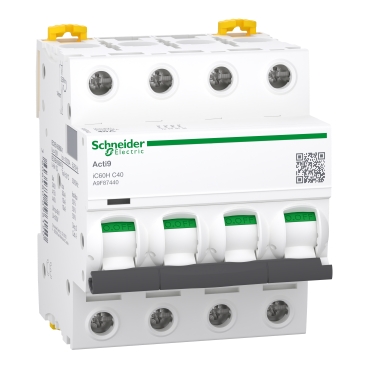Schneider A9F87440 | Miniature Circuit Breaker (MCB), Acti9, 1P, 40A, D Curve
2,657 EGP4,056 EGP (-34%)
Schneider A9F87440 | Miniature Circuit Breaker (MCB), Acti9, 1P, 40A, D Curve
Circuit breakers are essential components in electrical systems, providing protection against overcurrents and short circuits. This article will focus on the Schneider A9F87440, a miniature circuit breaker (MCB) known for its advanced features and reliable performance.
Schneider A9F87440
The Schneider A9F87440 is a 1-pole, 40A MCB from the Acti9 series, featuring a D curve. The D curve is designed for circuits with high inrush currents, such as those used in inductive loads like motors and transformers. This MCB is versatile, making it suitable for both residential and commercial applications where protection against high inrush currents is crucial.
How Circuit Breakers Work
Circuit breakers protect electrical systems by interrupting the power supply when they detect an overcurrent or short circuit. They continuously monitor the current flow and trip to stop the electricity when anomalies are detected, preventing potential damage to the electrical circuit and connected devices.
Types of Circuit Breakers
There are several types of circuit breakers, including Miniature Circuit Breakers (MCBs), Residual Current Circuit Breakers (RCCBs), and more. Each type serves a specific purpose, from protecting against overloads and short circuits to detecting residual currents.
Importance in Safety
Circuit breakers play a critical role in electrical safety by preventing overcurrents and short circuits, which can lead to fires, equipment damage, and electric shocks. Properly functioning circuit breakers are essential for maintaining the safety and reliability of electrical systems.
Installation Process
To install the Schneider A9F87440 circuit breaker, follow these steps:
- Turn off the main power: Ensure the main power supply is off to avoid any accidents.
- Identify the circuit: Determine the specific circuit where the MCB will be installed.
- Connect the MCB: Securely attach the MCB to the circuit, ensuring all connections are tight and correct.
- Test the installation: After installation, test the MCB to ensure it trips and resets properly.
Maintenance Tips
Regular maintenance is key to keeping your circuit breaker in optimal condition:
- Periodic testing: Regularly test the MCB to ensure it functions correctly.
- Inspect for damage: Check the MCB for any physical damage or signs of wear.
- Replace faulty units: If the MCB shows any signs of malfunction, replace it immediately to ensure continued safety.
Common FAQs
- What is the difference between an MCB and an RCCB?
- An MCB protects against overloads and short circuits, while an RCCB detects residual currents to prevent electric shocks.
- Can MCBs be used in residential applications?
- Yes, MCBs like the Schneider A9F87440 are suitable for both residential and commercial applications.
- What does the ‘D curve’ mean in an MCB?
- The ‘D curve’ indicates the MCB’s tripping characteristics, suitable for circuits with high inrush currents.
- How often should an MCB be tested?
- It is recommended to test MCBs at least once a year to ensure they are functioning properly.
- Are MCBs affected by environmental factors?
- Yes, extreme temperatures and humidity can impact MCB performance, so consider the installation environment carefully.
Conclusion
The Schneider A9F87440 MCB is a robust and versatile solution for protecting electrical circuits, especially those with high inrush currents. Proper installation and regular maintenance ensure its effectiveness in safeguarding electrical systems.








Reviews
There are no reviews yet.